

Grub's up: can insects feed the world? From the high windows of a warehouse in southern Spain a shaft of light falls on the white-gloved hand of insect farmer Laetitia Giroud.
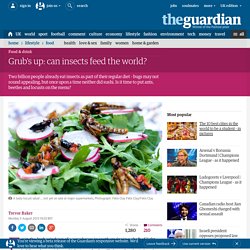
She is holding a large cricket, which sits perfectly still above the plastic box that is home to hundreds of its relatives. They're chirping to each other, giving the industrial unit a gently bucolic air. Nearby are another 30 or so boxes, filled with mealworms, black soldier flies and grasshoppers. "They have a great life," says Giroud, smiling at the elegantly poised insect. "They just eat and make love, eat and make love. " Paris-born Giroud unabashedly romanticises her charges, cooing over how "beautiful" the mealworms are and how they smell like honey.
While the world has been fascinated by Mark Post and his team's €250,000 attempt to make a stem cell burger at Maastricht University, there are many experts who think insects are a more likely protein source for a hungry world. The FSA appears to think "Yo! Buscan llevar insectos a dieta española. Una granja de insectos para alimentación en España. Por Inés Benítez.
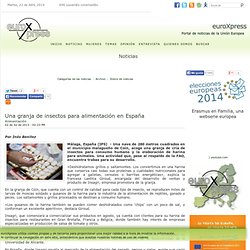
Edible Insect Market Hindered By Legal And Cultural Barriers. By Tierramerica By Inés Benítez A 280-square-metre warehouse in Coín, a municipality in the southern Spanish province of Málaga, is home to a unique type of farm, where insects are raised for human consumption and the production of animal feed.

But despite FAO’s endorsement of insects as food, there are numerous obstacles holding back the development of this industry. “We dehydrate the crickets and grasshoppers, then turn them into a flour that conserves almost all of their protein and other nutritional properties, which can be added to biscuits, cereal or energy bars,” explained Laetitia Giroud, a French national and the director of sales and product development at Insagri, the company that runs the farm. Quality control systems have been established for each type of insect raised at the farm in Coín.
“Mealworms can also be dehydrated and used to make chips with a bit of salt added, and make an excellent snack,” Giroud told Tierramérica. About the author: Tierramerica. Vil møte krisetider med insekter. Vil møte krisetider med insekter Men insektsavlerne i Spania møter motstand både i lovverket og i befolkningen.
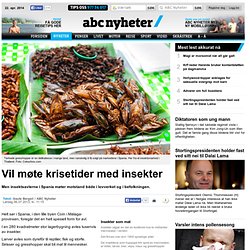
Men insektsavlerne i Spania møter motstand både i lovverket og i befolkningen. Helt sør i Spania, i den lille byen Coín i Málaga-provinsen, foregår det en helt spesiell form for avl. I en 280 kvadratmeter stor lagerbygning avles tusenvis av insekter. Larver avles som dyrefôr til reptiler, fisk og storfe. Sirisser og gresshopper skal bli mat til mennesker. – Vi tørker dem og ruller dem i en type mel som bevarer alle proteiner og annet næringsinnhold. Mercado de insectos tropieza con barrera legal y cultural española. Alimentación y agricultura, Ambiente, Biodiversidad, Comercio e inversiones, Desarrollo y ayuda, Destacados, Economía y comercio, Europa, Pobreza y Metas del Milenio, Proyectos, Tierramérica, Últimas Noticias La venta y el consumo de insectos, que según la FAO ayudará a combatir el hambre en el mundo, carece de regulación en España y en la mayoría de los demás países de Europa.

El curso "Investigando la biodiversidad: presente y futuro", organizado en mayo por la Universidad de Alicante, concluyó con una degustación de gusanos y arácnidos. Crédito: Cortesía Universidad de Alicante/Jesús Ordoñez. Una ración de grillos, saltamontes y larvas. Hace 10 años Laetitia Giroud dejó de comer carne.
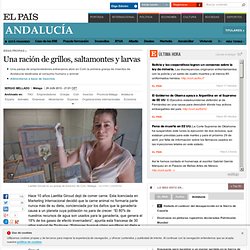
Esta licenciada en Marketing Internacional decidió que la carne animal no formaría parte nunca más de su dieta, concienciada por los daños que la ganadería causa a un planeta cuya población no para de crecer. “El 80% de nuestros recursos de agua son usados para la ganadería, que genera el 18% de los gases de efecto invernadero”, apunta esta francesa de 30 años natural de Toulouse. “Entonces busqué cómo equilibrar mi dieta e incluir las proteínas que dejaba de tomar por no comer carne”, recuerda. Www.tela-insecta.net. How Fly Farming May Help More Fish Stay In The Sea : The Salt. What's the lowly house fly got to do with the $60 billion fish farming industry?
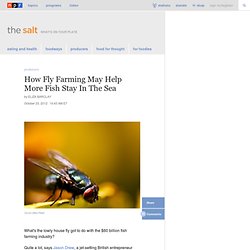
Quite a lot, says Jason Drew, a jet-setting British entrepreneur who is so enthusiastic about the potential of flies, he's just written a book called The Story of the Fly and How It Could Save the World. He thinks flies can solve one of aquaculture's most vexing issues: what to feed the growing ranks of farmed fish. Farm-raised salmon, trout and shrimp need a lot of animal protein in their diet. Right now, that protein comes mainly from small, wild fish that are turned into fish meal.
It takes about 3 pounds of fish to produce 1 pound of farmed salmon, and as we continue to deplete wild fish stocks, fisheries experts say we're going to run out. And so aquaculture experts all over the world are scrambling to figure out what to do about it. A few years back, Drew was checking out some farms in Saudi Arabia that were exporting chicken and shrimp to South Africa, where he lives. Courtesy of Jason Drew. Blog Central - Eat the Beetles (With Special Bug Recipes!) Entomos.
Le monde des insectes. En 2050 : nous mangerons des insectes. Español - Insagri.